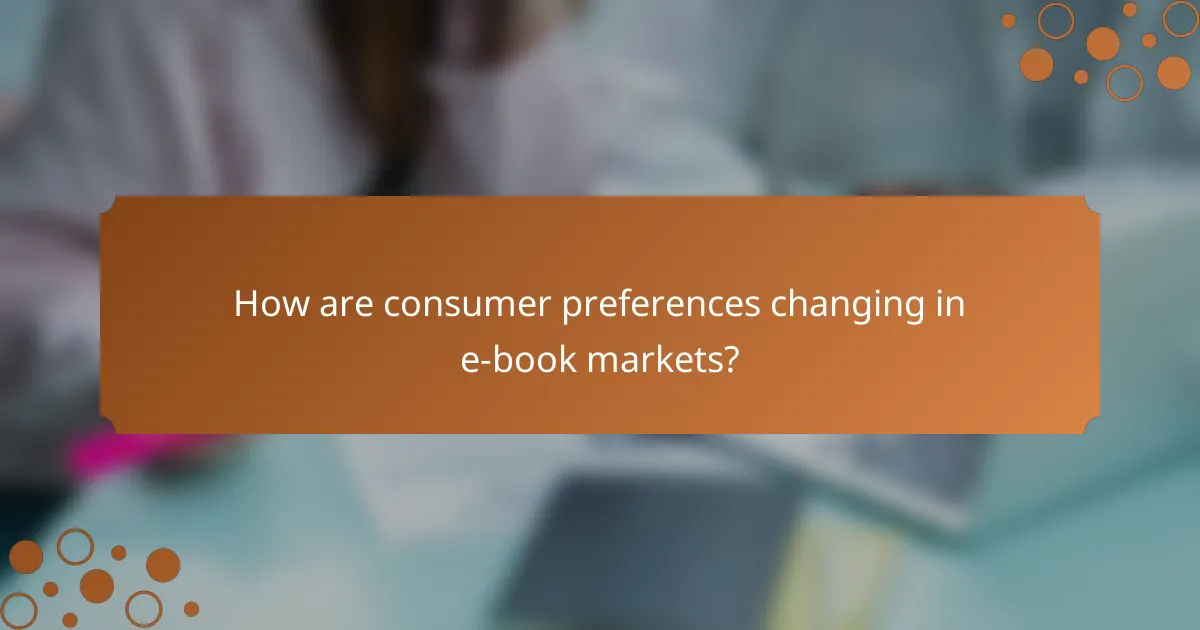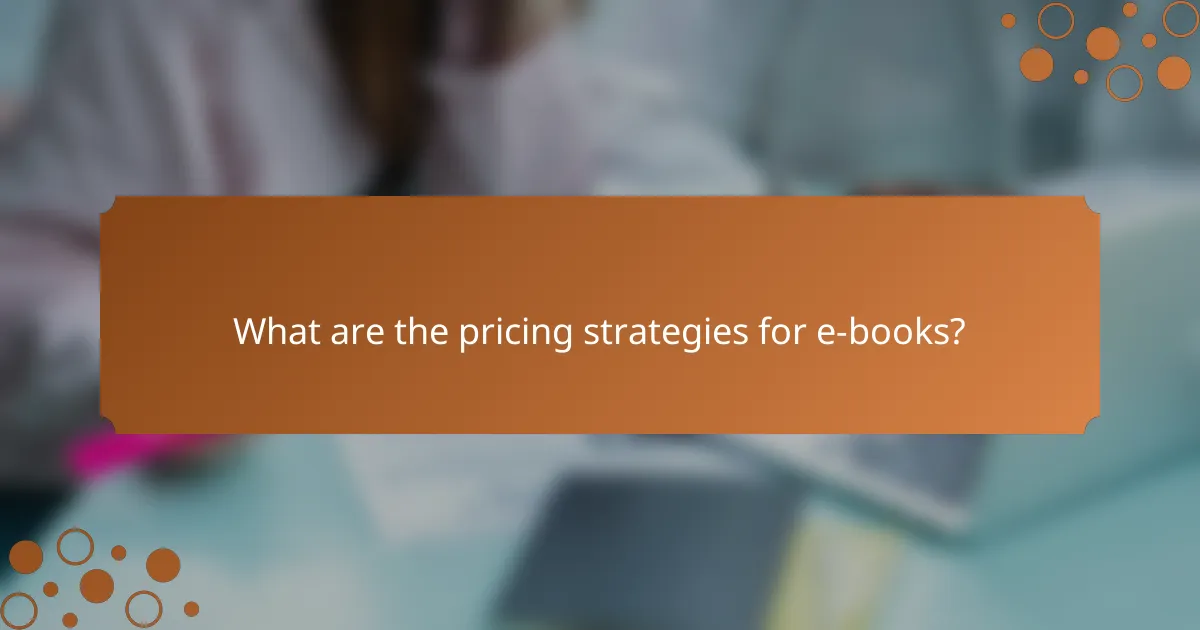The e-book landscape is evolving rapidly, influenced by consumer preferences and technological innovations. Trends such as the growing popularity of audiobooks, subscription models, and interactive features are reshaping how readers engage with content. As consumers increasingly seek personalized and mobile-friendly options, the demand for diverse genres and tailored recommendations continues to rise.

What are the current trends in e-books?
Current trends in e-books reflect a shift towards more engaging and accessible formats, driven by consumer preferences and technological advancements. Key developments include the rise of audiobooks, subscription services, and interactive content that enhance the reading experience.
Increased popularity of audiobooks
Audiobooks have gained significant traction, appealing to busy consumers who prefer listening over reading. This format allows multitasking, making it easier to consume literature during commutes or workouts.
Platforms like Audible and Google Play offer extensive libraries, often featuring exclusive content. The convenience of audiobooks is reflected in their growing market share, which has seen double-digit growth in recent years.
Growth of subscription services like Kindle Unlimited
Subscription services such as Kindle Unlimited provide readers with access to vast libraries for a monthly fee, enhancing the e-book experience. This model encourages exploration of various genres without the commitment of purchasing individual titles.
These services often include thousands of titles, catering to diverse reading preferences. Consumers benefit from the flexibility to read multiple books without incurring high costs, making it an attractive option for avid readers.
Rise of interactive e-books
Interactive e-books are becoming popular, especially in educational contexts, as they incorporate multimedia elements like quizzes, videos, and animations. This engagement enhances learning and retention, making reading more dynamic.
Publishers are increasingly adopting this format to appeal to younger audiences who expect more than traditional text. For example, children’s e-books often feature interactive storytelling that captivates young readers.
Focus on self-publishing platforms
Self-publishing has surged, allowing authors to bypass traditional publishing routes and reach audiences directly. Platforms like Amazon Kindle Direct Publishing empower writers to publish their work easily and retain more control over their content.
This trend has democratized the publishing landscape, enabling diverse voices and niche genres to thrive. Authors can quickly adapt to market demands, often leading to innovative storytelling approaches.
Integration of multimedia content
The integration of multimedia content in e-books enhances the reading experience by combining text with images, audio, and video. This trend caters to varied learning styles and keeps readers engaged.
For instance, textbooks now often include embedded videos that explain complex concepts, making them more accessible. As technology evolves, the potential for richer content in e-books continues to grow, appealing to a broader audience.

How are consumer preferences changing in e-book markets?
Consumer preferences in e-book markets are shifting towards more mobile-friendly options and personalized experiences. Readers are increasingly seeking content that resonates with their individual tastes, leading to a demand for tailored recommendations and a wider variety of genres and authors.
Preference for mobile reading devices
Mobile reading devices, such as smartphones and tablets, are becoming the preferred choice for e-book consumers. This trend is driven by the convenience of accessing a vast library of titles anywhere, anytime, without the need for dedicated e-readers.
As a result, e-book platforms are optimizing their apps for mobile use, ensuring features like adjustable text sizes and night modes are available. Publishers should consider mobile compatibility when designing e-books to enhance user experience.
Demand for personalized content recommendations
Consumers are increasingly expecting personalized content recommendations based on their reading habits and preferences. This trend is fueled by algorithms that analyze user behavior to suggest titles that align with individual interests.
To meet this demand, e-book retailers should invest in sophisticated recommendation systems that learn from user interactions. Offering tailored suggestions can significantly enhance customer satisfaction and encourage repeat purchases.
Interest in diverse genres and authors
There is a growing interest among readers for diverse genres and authors, reflecting a broader cultural shift towards inclusivity. Consumers are actively seeking out works from underrepresented voices and exploring genres outside their usual preferences.
Publishers and retailers should curate collections that highlight diverse authors and genres to attract this audience. This can include themed promotions or dedicated sections in e-book stores that celebrate multicultural literature and niche genres.

What are the pricing strategies for e-books?
E-book pricing strategies vary widely, focusing on maximizing sales while maintaining profitability. Key approaches include dynamic pricing, bundling with other digital products, and offering free promotional periods to attract readers.
Dynamic pricing models
Dynamic pricing models adjust e-book prices based on demand, competition, and consumer behavior. For instance, prices may fluctuate during peak buying seasons or in response to sales data, allowing publishers to optimize revenue. This strategy can lead to prices ranging from a few dollars to higher amounts depending on the book’s popularity and market trends.
Publishers should monitor market conditions and consumer feedback to effectively implement dynamic pricing. Tools that analyze sales patterns can help identify the best pricing points to maximize sales without sacrificing profit margins.
Bundling with other digital products
Bundling e-books with other digital products, such as audiobooks or online courses, can enhance perceived value and encourage purchases. For example, a reader might be more inclined to buy an e-book if it comes with a related audiobook at a discounted rate. This strategy can effectively increase overall sales and customer satisfaction.
When considering bundling, ensure that the combined products are relevant and appealing to your target audience. Offering bundles at a price that reflects a discount compared to purchasing items separately can drive higher sales volumes.
Free promotional periods
Free promotional periods allow consumers to download e-books at no cost for a limited time, which can significantly boost visibility and readership. This strategy often leads to increased reviews and word-of-mouth marketing, which can be beneficial for future sales. Authors may choose to offer their first book in a series for free to entice readers into purchasing subsequent titles.
To maximize the effectiveness of free promotions, consider timing them around holidays or special events. Additionally, promoting the free period through social media and email newsletters can help reach a broader audience and convert free readers into loyal customers.

How do e-book platforms compare?
E-book platforms vary significantly in terms of content selection, pricing, and user experience. Understanding these differences can help consumers choose the best platform for their reading preferences and habits.
Amazon Kindle vs. Apple Books
Amazon Kindle is known for its extensive library and integration with Amazon’s ecosystem, making it a popular choice for avid readers. In contrast, Apple Books offers a more curated selection with a focus on design and user experience, appealing to those who prefer a visually appealing interface.
When considering pricing, Kindle often features competitive pricing and frequent discounts, while Apple Books may have higher prices but offers exclusive titles and a seamless experience for Apple device users. Choosing between these two often comes down to device compatibility and personal preference for interface design.
Google Play Books vs. Kobo
Google Play Books provides a flexible purchasing model, allowing users to buy or rent e-books without a subscription, making it accessible for casual readers. Kobo, on the other hand, emphasizes its e-reader devices and offers a subscription service, which can be cost-effective for frequent readers.
Kobo’s integration with libraries through OverDrive allows users to borrow e-books, a feature not available on Google Play Books. If you prioritize borrowing options, Kobo may be the better choice, while Google Play Books is ideal for those who prefer to own their titles outright.
Comparison of user interfaces
User interface plays a crucial role in the overall reading experience. Kindle’s interface is straightforward, focusing on functionality with features like adjustable font sizes and background colors, which enhance readability. Apple Books, however, offers a more visually rich experience with animations and a sleek design that appeals to users who value aesthetics.
Kobo’s interface is user-friendly and emphasizes personalization, allowing users to customize their reading settings extensively. Google Play Books features a clean layout but may lack some advanced customization options found in other platforms. Ultimately, the best interface depends on individual preferences for usability versus visual appeal.

What are the key factors influencing e-book sales?
Key factors influencing e-book sales include pricing strategies, consumer preferences, and technological advancements. Understanding these elements helps publishers and authors tailor their offerings to meet market demands effectively.
Marketing strategies and social media impact
Effective marketing strategies significantly boost e-book sales by enhancing visibility and engagement. Utilizing social media platforms allows authors and publishers to connect directly with readers, promoting new releases and special offers.
Content marketing, such as blog posts or podcasts related to the e-book’s themes, can also attract potential buyers. Engaging with readers through interactive posts or live Q&A sessions can create a loyal community, driving sales through word-of-mouth recommendations.
Consider leveraging targeted ads on platforms like Facebook or Instagram, where demographics can be finely tuned. A well-planned campaign can increase e-book sales by reaching the right audience at the right time, often resulting in higher conversion rates.
